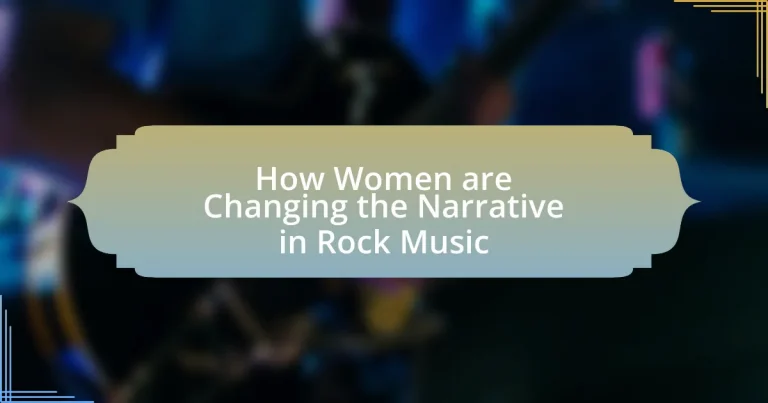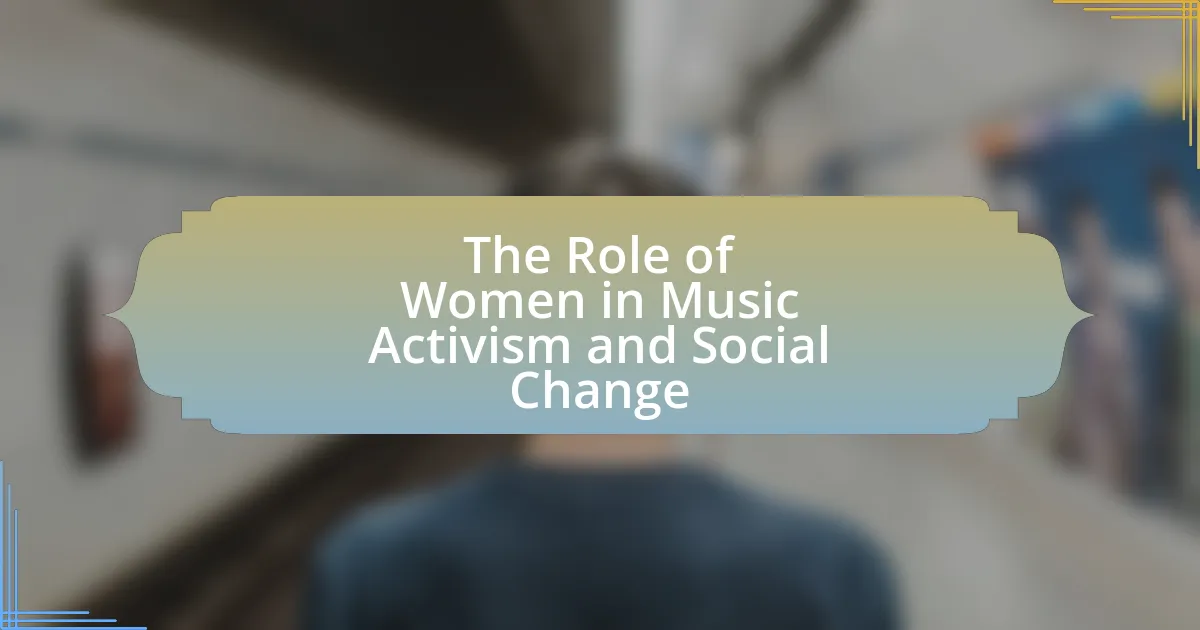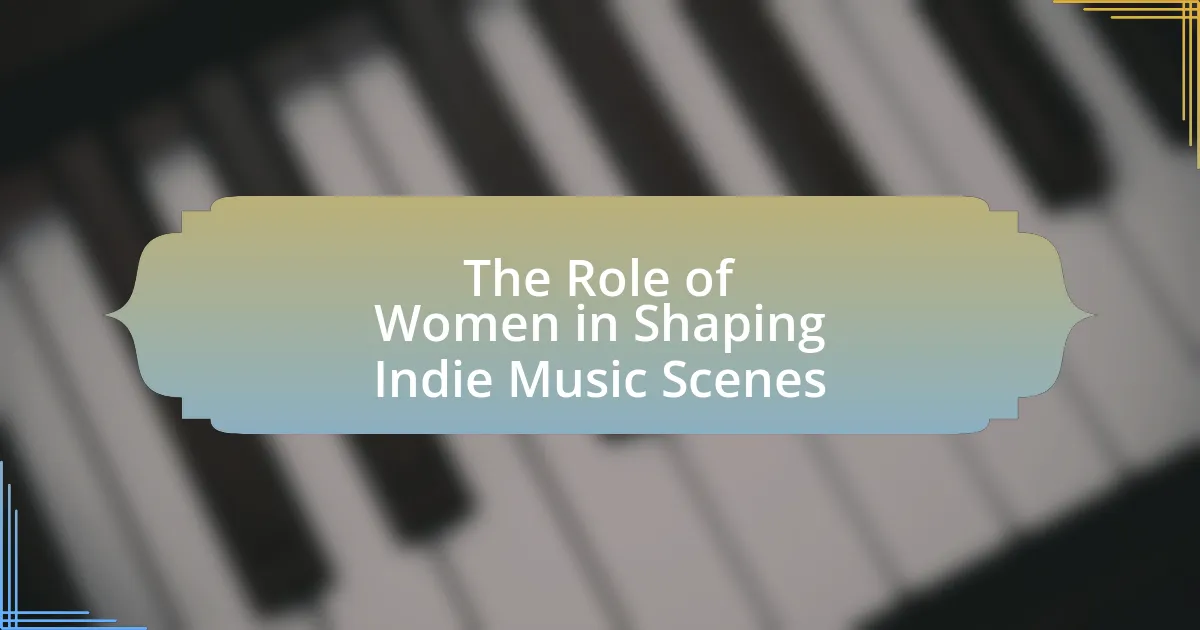The article examines how women are transforming the rock music scene by breaking barriers, redefining genres, and promoting inclusivity. It highlights the historical context that has shaped women’s roles in rock, the challenges they face, and the significant contributions of contemporary female artists. Key statistics reveal an increase in female representation at music festivals and in the industry, while discussions on mentorship programs and organizations dedicated to supporting women in music underscore the ongoing efforts to address gender inequality. The article emphasizes the importance of representation and the impact of female artists on the sound, style, and narrative of modern rock music.
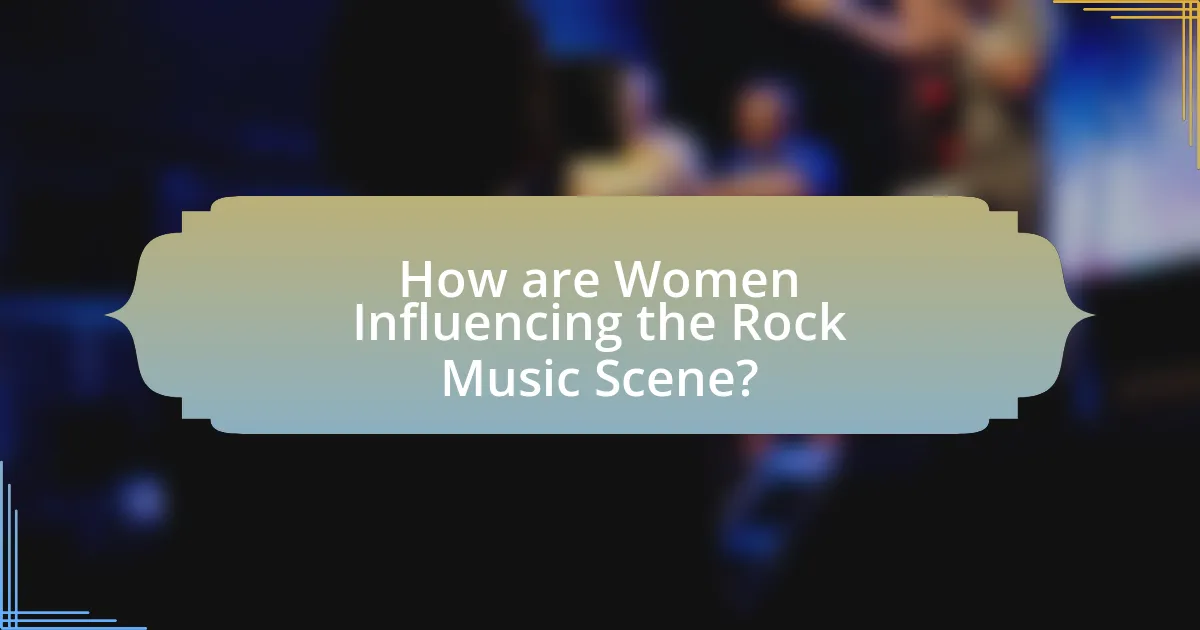
How are Women Influencing the Rock Music Scene?
Women are influencing the rock music scene by breaking barriers, redefining genres, and leading movements that promote inclusivity and diversity. Female artists such as Joan Jett, Paramore’s Hayley Williams, and more recently, artists like H.E.R. and Phoebe Bridgers, have challenged traditional gender roles within the industry. Their presence has led to increased visibility for women in rock, with statistics showing that female representation in rock festivals has risen significantly, from 15% in 2015 to over 30% in 2022. This shift not only empowers aspiring female musicians but also encourages a broader acceptance of diverse voices in rock music, reshaping the narrative around the genre.
What historical context has shaped women’s roles in rock music?
Women’s roles in rock music have been shaped by a historical context that includes the feminist movements of the 1960s and 1970s, which challenged gender norms and advocated for equality. The emergence of female rock artists like Janis Joplin and Joan Jett during this period demonstrated that women could be powerful figures in a male-dominated genre. Additionally, the backlash against traditional gender roles in the 1980s and 1990s, exemplified by the Riot Grrrl movement, further empowered women to express their identities and experiences through rock music. This historical backdrop has led to a gradual but significant shift in the perception and participation of women in rock, allowing for greater representation and influence in the industry.
How did early female rock musicians pave the way for future generations?
Early female rock musicians paved the way for future generations by breaking gender barriers and establishing a presence in a male-dominated industry. Artists like Joan Jett, Patti Smith, and Debbie Harry not only showcased their musical talents but also challenged societal norms regarding women’s roles in music. Their success demonstrated that women could be both performers and songwriters, influencing countless female artists who followed. For instance, Joan Jett’s band, The Runaways, was one of the first all-female rock bands to gain significant attention, inspiring later groups like The Donnas and Paramore. This legacy of empowerment and visibility has led to a more inclusive rock music scene, where female musicians continue to thrive and innovate.
What barriers have women faced in the rock music industry?
Women in the rock music industry have faced significant barriers, including gender discrimination, lack of representation, and sexual harassment. Gender discrimination manifests in the form of fewer opportunities for women to perform, record, and be promoted compared to their male counterparts. For instance, a study by the Annenberg Inclusion Initiative found that only 22.4% of artists on popular music charts were women from 2012 to 2019. Lack of representation is evident in the predominance of male-led bands and the underrepresentation of women in music festivals and award nominations. Additionally, sexual harassment remains a pervasive issue, with many women reporting uncomfortable or unsafe working environments. These barriers collectively hinder women’s progress and visibility in the rock music scene.
What are the current trends of women in rock music?
Current trends of women in rock music include a significant increase in female representation in bands, a rise in solo female artists, and a growing emphasis on diversity and inclusivity within the genre. Female musicians are not only gaining visibility but also achieving commercial success, with artists like Haim, Phoebe Bridgers, and Lizzo leading the charge. According to a 2022 report by the Annenberg Inclusion Initiative, women made up 23.3% of artists in the rock genre, a notable increase from previous years. Additionally, women are increasingly taking on roles as producers and songwriters, further shaping the sound and direction of rock music. This shift reflects a broader cultural movement towards gender equality and empowerment in the music industry.
How are contemporary female artists redefining rock music genres?
Contemporary female artists are redefining rock music genres by incorporating diverse influences, challenging traditional gender roles, and experimenting with new sounds. Artists like St. Vincent and Haim blend rock with pop, electronic, and indie elements, creating innovative music that expands the genre’s boundaries. Additionally, figures such as Lizzo and Phoebe Bridgers address social issues and personal narratives in their lyrics, reshaping the thematic content of rock music. This evolution is evidenced by the increasing presence of women in major rock festivals and charts, reflecting a shift in industry dynamics and audience expectations.
What impact do female-led bands have on the rock music landscape?
Female-led bands significantly reshape the rock music landscape by challenging gender norms and expanding the genre’s diversity. These bands, such as The Runaways and Heart, have historically paved the way for female musicians, demonstrating that women can excel in a male-dominated industry. Their presence has led to increased visibility for female artists, encouraging more women to pursue careers in rock music. According to a 2020 study by the Annenberg Inclusion Initiative, only 22.5% of artists in popular music were women, highlighting the ongoing need for representation. Female-led bands not only inspire future generations but also contribute to a broader range of themes and perspectives within rock music, enriching the genre as a whole.
Why is representation important in rock music?
Representation is important in rock music because it ensures diverse voices and perspectives are included, which enriches the genre and fosters a more inclusive culture. Historically, rock music has been dominated by male artists, limiting the expression of different experiences and identities. For instance, the rise of female rock musicians like Joan Jett and Paramore’s Hayley Williams has challenged stereotypes and inspired new generations, demonstrating that women can excel in a traditionally male-dominated space. Studies show that increased representation leads to broader audience engagement and can drive innovation within the genre, as diverse artists bring unique influences and styles.
How does increased visibility of women in rock influence young musicians?
Increased visibility of women in rock positively influences young musicians by providing relatable role models and challenging gender stereotypes. This visibility encourages young female musicians to pursue their passion for music, as they see successful women like Joan Jett and St. Vincent breaking barriers in a traditionally male-dominated genre. Research from the University of Southern California’s Annenberg Inclusion Initiative highlights that female representation in music can inspire young girls to engage in creative fields, fostering a more inclusive environment. As a result, the presence of women in rock not only empowers aspiring musicians but also contributes to a broader cultural shift towards gender equality in the music industry.
What role do female artists play in challenging stereotypes within the genre?
Female artists play a crucial role in challenging stereotypes within the rock genre by redefining traditional gender roles and showcasing diverse expressions of identity. They confront the male-dominated narratives by not only excelling in musicianship but also by addressing themes of empowerment, sexuality, and personal struggle in their lyrics. For instance, artists like Joan Jett and Paramore’s Hayley Williams have broken barriers by achieving commercial success and critical acclaim, thereby proving that women can lead in a genre often perceived as male-centric. Their visibility and success inspire a new generation of female musicians, encouraging them to pursue careers in rock music and challenge the status quo.
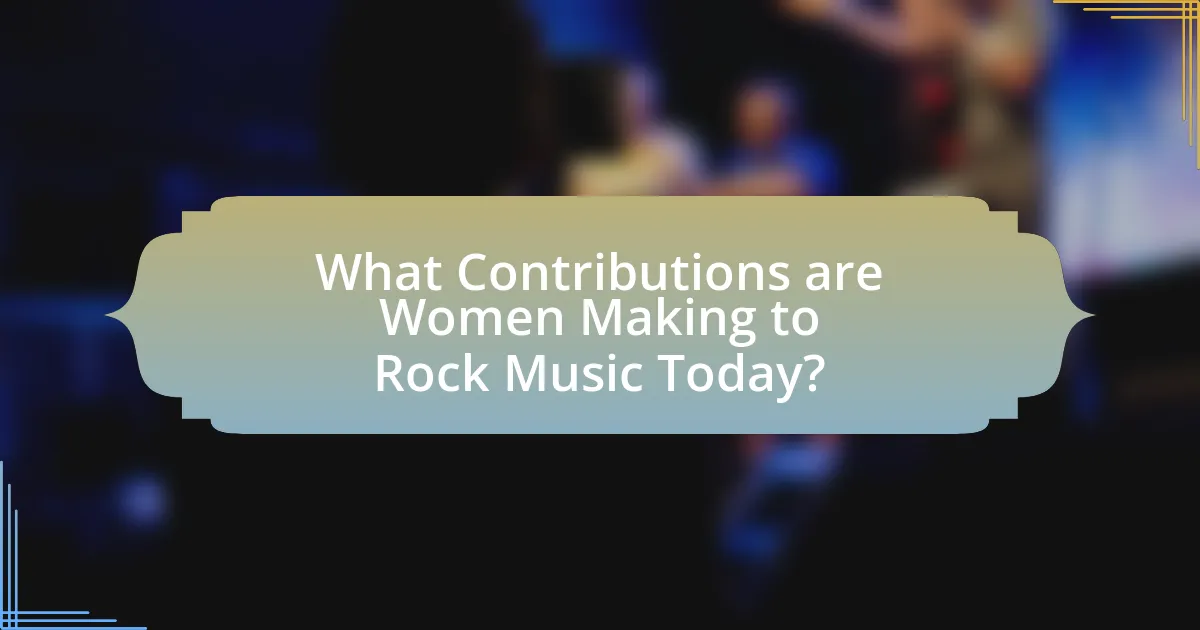
What Contributions are Women Making to Rock Music Today?
Women are significantly contributing to rock music today by leading bands, producing music, and influencing genres. Prominent figures like Hayley Williams of Paramore and St. Vincent are not only performing but also writing and producing their own music, showcasing their artistic control and innovation. Additionally, women are increasingly represented in music festivals and award nominations, with artists like Billie Eilish and Haim receiving critical acclaim and commercial success. According to a 2021 report by the Annenberg Inclusion Initiative, women made up 22.5% of artists in popular music, indicating a growing presence and impact in the industry. This shift is reshaping the narrative around rock music, highlighting diverse voices and perspectives that were historically underrepresented.
How are women shaping the songwriting and production process in rock music?
Women are significantly shaping the songwriting and production process in rock music by bringing diverse perspectives and innovative approaches to the creative process. Female songwriters and producers, such as Linda Perry and Tori Amos, have not only contributed to the lyrical content but have also influenced the sound and structure of rock music through their unique styles and techniques. Research indicates that female artists are increasingly taking on roles traditionally held by men, with a 2021 report from the Annenberg Inclusion Initiative revealing that women accounted for 22.5% of songwriters in popular music, a notable increase from previous years. This shift is fostering a more inclusive environment that encourages collaboration and experimentation, ultimately enriching the genre.
What unique perspectives do female songwriters bring to their music?
Female songwriters bring diverse emotional depth and personal experiences to their music, often reflecting themes of empowerment, vulnerability, and social issues. This unique perspective allows them to challenge traditional narratives within rock music, as seen in the works of artists like Alanis Morissette and Florence Welch, who address topics such as mental health and gender inequality. Research indicates that female songwriters often incorporate storytelling that resonates with a broader audience, enhancing relatability and connection in their lyrics. This distinct approach not only enriches the genre but also contributes to a more inclusive representation in rock music.
How are women influencing the sound and style of modern rock music?
Women are significantly influencing the sound and style of modern rock music by introducing diverse perspectives, innovative songwriting, and unique vocal styles. Artists like Hayley Williams of Paramore and St. Vincent have pushed the boundaries of rock by blending genres such as pop, punk, and electronic music, creating a more eclectic sound. Additionally, the rise of female-led bands and solo acts has led to a shift in lyrical themes, often addressing issues like empowerment, mental health, and social justice, which resonate with a broader audience. The presence of women in rock has also increased visibility and representation, encouraging more female musicians to enter the industry, as evidenced by the growing number of women featured in major music festivals and award nominations.
What initiatives support women in the rock music industry?
Initiatives that support women in the rock music industry include organizations like Girls Rock Camp, which empowers young girls through music education and mentorship, and She Rocks Awards, which honors women in the music industry for their contributions. Additionally, the Women’s International Music Network provides networking opportunities and resources for women musicians. These initiatives are crucial as they address the gender disparity in the industry, where women are often underrepresented. For instance, a study by the USC Annenberg Inclusion Initiative found that only 21.7% of artists on the Billboard Hot 100 were women in 2019, highlighting the need for such supportive programs.
How do mentorship programs help aspiring female rock musicians?
Mentorship programs help aspiring female rock musicians by providing guidance, industry connections, and skill development. These programs often pair emerging artists with experienced musicians who can offer insights into navigating the music industry, including performance techniques, songwriting, and marketing strategies. For instance, a study by the Berklee College of Music found that mentorship significantly increases the likelihood of success for female musicians, as they gain access to networks that can lead to opportunities for gigs and collaborations. Additionally, mentorship fosters confidence and resilience, essential traits for overcoming the challenges faced in a male-dominated genre like rock music.
What organizations are dedicated to promoting women in rock music?
Organizations dedicated to promoting women in rock music include the Women’s International Music Network (WIMN), which supports female musicians through networking and resources, and She Rocks Awards, which honors women in the music industry. Additionally, the Rock and Roll Hall of Fame has initiatives aimed at recognizing female artists’ contributions. These organizations provide platforms for women to gain visibility and support within the rock music scene, thereby fostering a more inclusive environment.
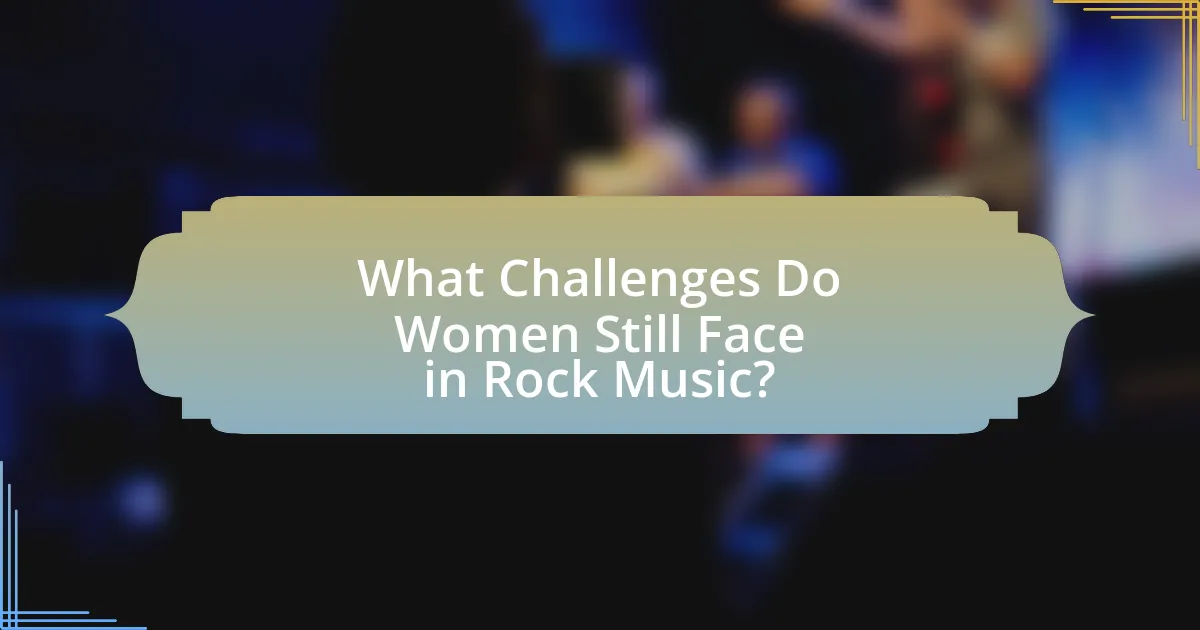
What Challenges Do Women Still Face in Rock Music?
Women in rock music face significant challenges, including gender bias, underrepresentation, and a lack of access to industry resources. Gender bias manifests in the form of stereotypes that question women’s musical abilities and contributions, often leading to fewer opportunities for women artists compared to their male counterparts. Underrepresentation is evident in festival lineups and award nominations, where women are frequently outnumbered by men; for instance, a 2020 study found that only 22% of artists at major music festivals were women. Additionally, women often encounter barriers in accessing funding, mentorship, and networking opportunities, which are crucial for career advancement in the music industry. These challenges hinder women’s visibility and success in rock music, perpetuating a cycle of inequality.
What are the ongoing issues of gender inequality in the rock music industry?
Ongoing issues of gender inequality in the rock music industry include underrepresentation of women in key roles, pay disparity, and sexual harassment. Women comprise only about 20% of artists in the rock genre, indicating a significant gender gap in visibility and opportunities. Additionally, studies show that female musicians often earn less than their male counterparts for similar work, contributing to economic inequality. Furthermore, a survey by the Music Industry Research Association found that 70% of women in the industry reported experiencing sexual harassment, highlighting a pervasive culture of discrimination and abuse. These factors collectively hinder women’s full participation and recognition in the rock music scene.
How do pay disparities affect female rock musicians?
Pay disparities significantly hinder female rock musicians by limiting their financial resources and opportunities for growth. Female musicians often earn less than their male counterparts, which can restrict their ability to invest in their careers, such as producing music, marketing, and touring. For instance, a study by the USC Annenberg Inclusion Initiative found that women in the music industry earned only 60% of what men earned in comparable roles. This economic inequality not only affects their current financial stability but also perpetuates a cycle of underrepresentation and lack of visibility in the industry, making it harder for female rock musicians to gain recognition and support.
What challenges do women face in gaining media coverage and recognition?
Women face significant challenges in gaining media coverage and recognition, primarily due to systemic biases and stereotypes within the industry. Research indicates that female musicians are often underrepresented in media narratives, with studies showing that only 21% of artists played on radio stations are women, highlighting a gender disparity in visibility. Additionally, women frequently encounter stereotypes that question their authenticity and expertise in rock music, which can lead to diminished opportunities for coverage and recognition. This lack of representation not only affects individual artists but also perpetuates a cycle that discourages new female talent from entering the industry.
How can the rock music industry improve for women?
The rock music industry can improve for women by implementing equitable hiring practices and increasing representation in decision-making roles. Research indicates that women are underrepresented in various aspects of the music industry, with only 21% of artists being female according to the 2021 USC Annenberg Inclusion Initiative. By actively promoting female talent in both performance and production roles, the industry can create a more inclusive environment. Additionally, establishing mentorship programs for women in rock can provide support and guidance, fostering a culture that encourages female participation and leadership.
What strategies can be implemented to promote gender equality in rock music?
To promote gender equality in rock music, strategies such as increasing representation of women in music festivals, implementing mentorship programs for female artists, and advocating for equitable hiring practices in the industry can be implemented. Increasing representation can be evidenced by initiatives like the “Women in Music” campaign, which aims to ensure that female artists are featured prominently in lineups, addressing the historical underrepresentation of women in rock. Mentorship programs, such as those offered by organizations like She Rocks, provide guidance and support to emerging female musicians, fostering a more inclusive environment. Additionally, advocating for equitable hiring practices can be supported by research indicating that diverse teams lead to better creative outcomes, as highlighted in studies by McKinsey & Company, which show that companies with more women in leadership roles perform better financially.
How can audiences support female artists in the rock genre?
Audiences can support female artists in the rock genre by actively attending their concerts and purchasing their music. This direct financial support helps female artists gain visibility and sustain their careers. According to a 2021 report by the Annenberg Inclusion Initiative, female artists represent only 21.6% of artists in popular music, highlighting the need for increased support. By promoting female rock artists on social media and sharing their music, audiences can amplify their reach and encourage more equitable representation in the industry. Engaging with female artists through fan clubs or crowdfunding platforms also provides essential resources for their creative projects.
What practical steps can aspiring female rock musicians take to succeed?
Aspiring female rock musicians can succeed by actively networking within the music industry, honing their musical skills, and leveraging social media platforms for visibility. Networking allows musicians to connect with industry professionals, collaborate with other artists, and gain access to performance opportunities. For instance, attending music festivals, workshops, and local gigs can facilitate these connections.
Additionally, developing strong musical skills through practice and education, such as taking lessons or participating in music programs, enhances their performance quality and songwriting abilities. According to a study by the Women’s Audio Mission, women who engage in music education are more likely to pursue careers in music.
Finally, utilizing social media effectively can help female rock musicians build a fan base and promote their work. Platforms like Instagram, TikTok, and YouTube allow artists to share their music, engage with fans, and showcase their unique style, which is crucial in a competitive industry. Statistics show that artists who actively engage on social media can increase their visibility and reach a broader audience.
How can networking and collaboration enhance opportunities for women in rock music?
Networking and collaboration can significantly enhance opportunities for women in rock music by creating supportive communities and facilitating access to resources. Women who engage in networking can share experiences, gain mentorship, and find collaborators, which can lead to increased visibility and career advancement. For instance, initiatives like She Rocks Awards and organizations such as Girls Rock Camp provide platforms for women to connect and showcase their talents, resulting in more opportunities for performances and industry recognition. Additionally, collaborative projects often lead to innovative music that can attract diverse audiences, further amplifying women’s presence in the rock genre.
What resources are available for women pursuing a career in rock music?
Women pursuing a career in rock music can access various resources, including mentorship programs, networking organizations, and educational initiatives. Organizations like Girls Rock Camp provide hands-on music education and empowerment for young women, while the Women’s International Music Network offers networking opportunities and resources tailored for women in the music industry. Additionally, platforms such as She Rocks Awards celebrate female musicians and industry professionals, promoting visibility and support. These resources collectively foster an inclusive environment, enabling women to thrive in the rock music scene.
